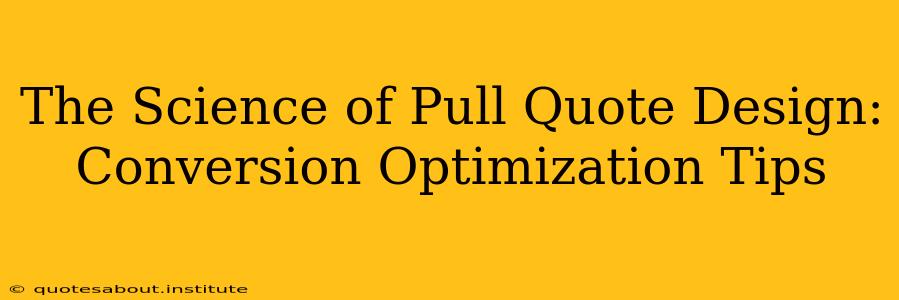Pull quotes. Those enticing snippets of text plucked from the body of your article, visually highlighted to grab the reader's attention. They're more than just pretty design elements; they're powerful tools for conversion optimization when used strategically. This post delves into the science behind effective pull quote design, exploring how to leverage them to boost engagement and drive conversions.
What Makes a Great Pull Quote?
Before diving into design specifics, let's establish the foundation. A compelling pull quote isn't just a random sentence ripped from your text. It needs to be:
- Compelling: It should capture the essence of your message, offering a concise and impactful summary of a key point. Think "headline in miniature."
- Actionable: Ideally, it should inspire the reader to take a specific action, whether it's reading on, clicking a link, or making a purchase.
- Relevant: It must directly relate to the overall message and target audience. An irrelevant quote will confuse and frustrate readers.
- Concise: Brevity is key. Keep it short and sweet; long pull quotes lose their impact. Aim for under 40 words.
How to Design Effective Pull Quotes for Conversions
Now let's move on to the design aspects, which are just as crucial as the content itself:
Font Choice:
The font you choose significantly impacts readability and the overall feel of your pull quote. Serif fonts (like Times New Roman or Garamond) often read better in longer blocks of text, while sans-serif fonts (like Arial or Helvetica) tend to work better for shorter, impactful quotes. Choose a font that complements your overall website design and enhances readability.
Color Contrast:
Ensure sufficient contrast between the text color and the background. High contrast makes the pull quote easily scannable and prevents eye strain. Experiment with different color combinations to find what best suits your brand and design aesthetic. Consider using your brand colors for a cohesive look.
Size and Placement:
The size of your pull quote should be larger than the surrounding body text to draw attention. Experiment with different sizes to find the optimal balance between visibility and integration with the overall design. Placement is also crucial. Strategically place it within the article where it will have the most impact.
Visual Elements:
Consider adding simple visual elements to further enhance the pull quote's impact. This could include a subtle background color, a border, or a simple graphic element that complements your brand. Keep it clean and avoid clutter.
Using Different Styles for Different Purposes:
Experiment with different styles for varied effects:
- Bold and Concise: For impactful statements that need immediate attention.
- Subtle and Informative: For quotes that provide valuable context or detail.
- Question-Based: To engage the reader and pique their curiosity.
Choosing the Right Pull Quotes: A Data-Driven Approach
Don't just randomly select sentences. Analyze your content and identify the most impactful and engaging sections. Consider A/B testing different pull quotes to see which performs best in terms of engagement and conversions. Track metrics like click-through rates and time spent on page to determine effectiveness.
How Can I Make My Pull Quotes More Engaging?
One effective strategy is to use pull quotes to highlight customer testimonials or expert opinions. These add social proof and build trust. Another approach is to make them interactive, using a question or a thought-provoking statement to encourage reader participation.
What is the Best Length for a Pull Quote?
Generally, shorter is better. Aim for around 25-40 words. Longer quotes can become overwhelming and lose their impact.
What are Some Examples of Successful Pull Quotes?
Look at high-performing websites in your industry. Analyze the pull quotes they use, paying attention to their design, placement, and content. This can provide valuable inspiration and insights.
Conclusion
Pull quotes, when designed and implemented strategically, are incredibly valuable tools for conversion optimization. By understanding the science behind their design and employing a data-driven approach, you can significantly improve engagement and guide your readers towards desired actions. Remember, it’s a combination of compelling content and thoughtful design that leads to success.

